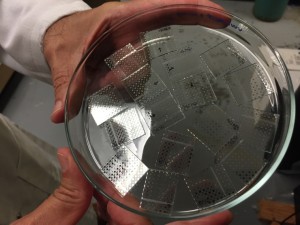
The new hybrid sol-gel material provides an electrical energy storage capacity rivaling some batteries.
Image: John Toon/Georgia Tech
The future of electric vehicle and defibrillator technologies depend largely on new, innovative energy storage research and improving device power densities. With the high demand for more powerful, efficient energy devices, the researchers from Georgia Tech believe they may have developed what could be the answer to powering large-scale devices.
The team has developed a new capacitor dielectric material. This capacitor—developed from a hybrid silica sol-gel material and self-assembled monolayers of common fatty acid—has the potential to surpass some of today’s conventional batteries in the field of energy and power density.
If the researchers can scale up their current laboratory sample, the new capacitors will be able to provide large amounts of current quickly to large-scale applications.
This from Georgia Tech:
The new material is composed of a silica sol-gel thin film containing polar groups linked to the silicon atoms and a nanoscale self-assembled monolayer of an octylphosphonic acid, which provides insulating properties. The bilayer structure blocks the injection of electrons into the sol-gel material, providing low leakage current, high breakdown strength and high energy extraction efficiency.
“Sol-gels with organic groups are well known and fatty acids such as phosphonic acids are well known,” noted Joseph Perry, co-author of the study. “But to the best of our knowledge, this is the first time these two types of materials have been combined into high-density energy storage devices.”
In addition to Perry, past ECS member Yohan Park contributed to this research.
To the team’s knowledge, this is the first time a capacitor has outpaced a battery on energy density. If the material properties transfer to larger devices, the commercialization of this produce could advance electronics and maximize energy storage applications.
ICYMI: Listen to our podcast with NREL’s John A. Turner on how technology will affect the future of the energy infrastructure.
And make sure to attend the 228th ECS Meeting where we’ll be hosting the fifth international Electrochemical Energy Summit!

